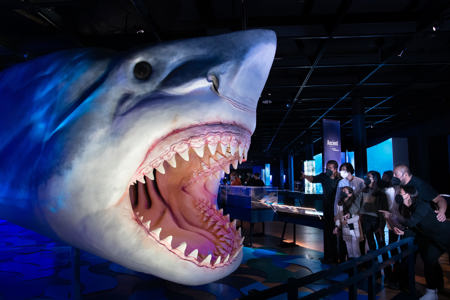

Sharks
American Museum of Natural History
Agency: Sharks
Client: American Museum of Natural History
As visitors entered the exhibition, they were greeted by the gaping 27 foot long jaws of a scientifically accurate model of megalodon—the biggest predatory fish of all time. Visitors were surrounded by dynamic media displays of sharks gliding alongside them, inviting them into a colorful, engaging and immersive ocean world. Fossils from the museum’s extensive palaeoichthyology collection were showcased alongside interpretation informed by the latest research. To bring these fossils to life, the exhibit included a spectacular “parade” of life-size ancient and modern sharks, ranging from 5 inches to 33 feet long, including the prehistoric mega-predator megalodon, the “Tyrannosaurus rex of the seas.” Many of the models were made in-house by the AMNH’s world-renowned model makers specifically for this exhibit, and roughly a third were reused from the museum’s storage to promote sustainability. Visitors also learned about new discoveries, including a great white nursery near New York City, how manta rays filter-feed, and a kitefin shark that is the largest-known glowing vertebrate. The exhibit also highlighted various threats facing sharks as well as efforts by dedicated people working hard to protect them through conservation solutions such as shark sanctuaries and sustainable seafood products. The pandemic was still a concern when Sharks was at the AMNH, so touchless interactive experiences were critical to engage visitors safely. Using a touchless interactive pattern-matching game, visitors learned how scientists use the spots on whale sharks (like fingerprints) to identify individual fish. Another touchless interactive used motion sensors to allow visitors to “hunt like a hammerhead” using the shark’s sense of electro reception (which allows sharks to detect invisible electromagnetic fields to find food). The exhibit concluded with a third touchless interactive that invited visitors to “be a shark” by standing in front of a video display where they were transformed into various species, as if swimming with the sharks. As a travelling exhibit, Sharks is environmentally sustainable. It will be reused and recycled by visiting several museums and will be enjoyed by thousands of museum visitors all over the world for many years to come, which means it will have a lower carbon footprint than a one-off temporary exhibit.